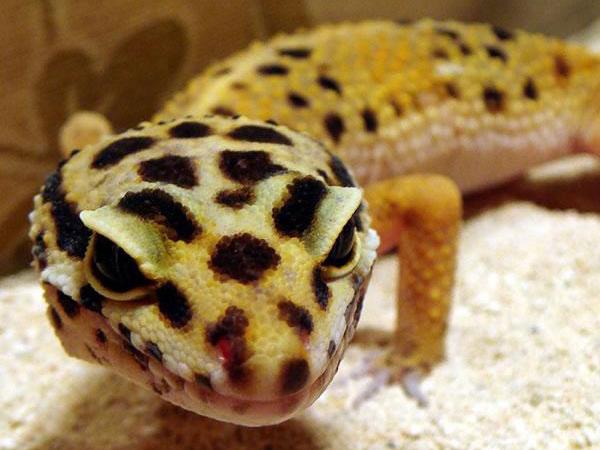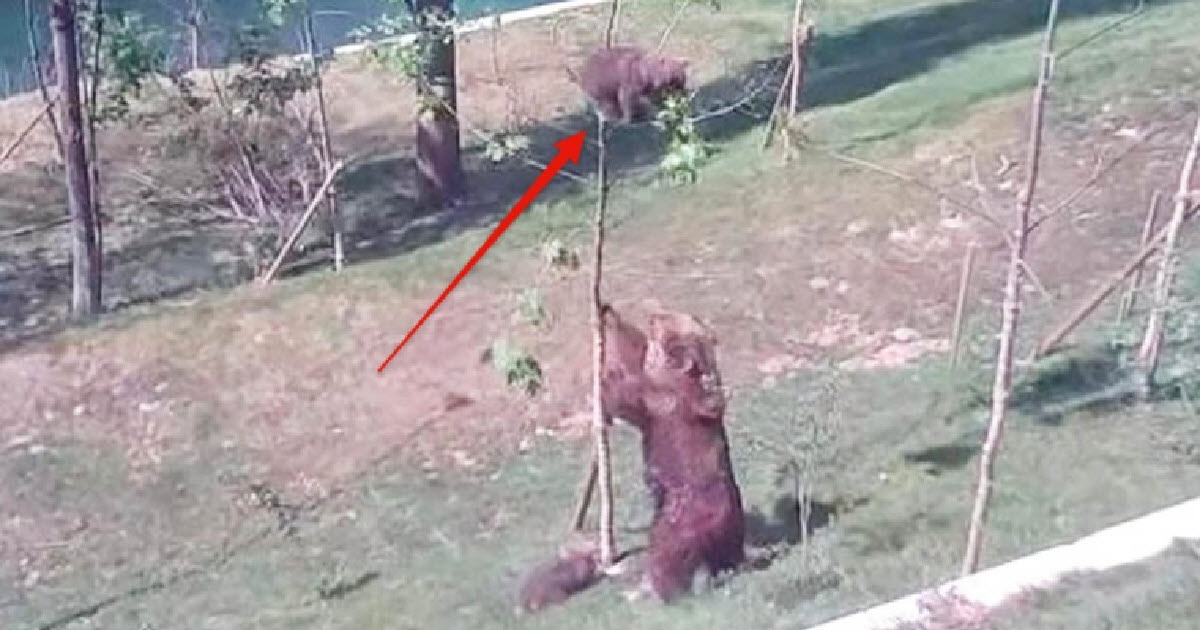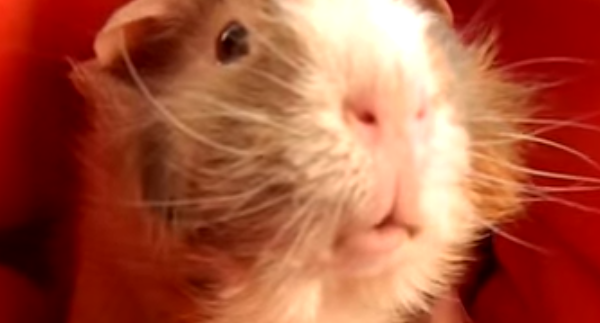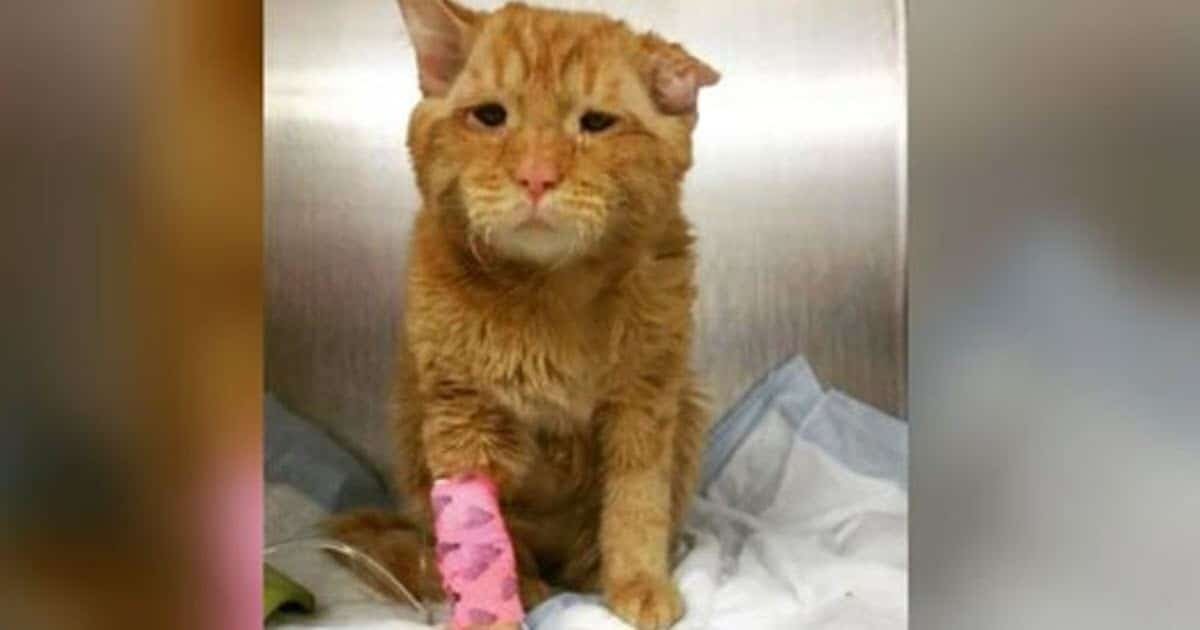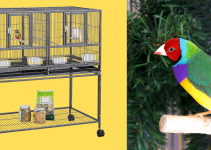Leopard geckos appear to smile without teeth when they are young. However, they must have some form of denticles to be able to eat, right? The question is, do Leopard geckos teeth exist? Why can’t you see them and how many are there?
Newly born leopard geckos have 100 scarcely perceptible conical teeth in the shape of pegs on both their upper and lower jaws. The polyphyodont nature of these vibrant reptiles enables them to replace teeth on average every three to four months during their lifespan.
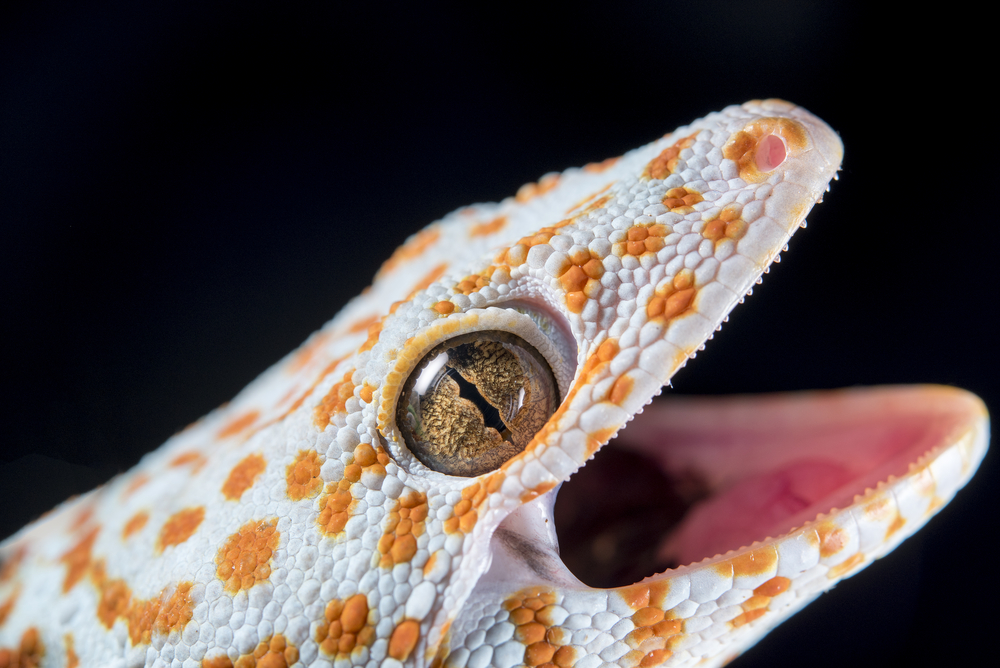
Why Do Leopard Geckos Have Several Teeth?
Did you know that leopard geckos gulp their food rather than chew it? Hence, why would they require even one tooth, much less one hundred? Even their alignment does not encourage grinding and chewing.
So, to prevent its feisty bug prey from escaping, your Leopard gecko must snap at predators and grab food before swallowing it.
Inside The Mouth of a Leopard Gecko
The hidden tooth arrangement and other mouth parts of your Leopard gecko’s mouth are highlighted in the table below:
MOUTH COMPONENT DESCRIPTION Number of Teeth Leos are born with 100 teeth, on average. Type of Teeth Pleurodont teeth; small, conical, pointed-tips with varied structure (more on that later). Jaw Margin Consisting of the maxilla, premaxilla, and dentary bones. Premaxilla Bone Positioned near the upper jaw’s tip. 9–13 teeth are fixed to the premaxilla bone in leopard geckos. Upper Jaw Contains the premaxilla and maxilla bones. The upper jaw of a leopard gecko has more teeth than the lower. Due to the ongoing loss and regeneration of teeth, it is difficult to determine the exact figures. Lower Jaw Dentary bone (the only bone found in the lower jaw).
Do Leopard Geckos Lose Their Teeth?
Leo needs to lose several of his teeth to make room for dental replacements.
As a result, as your reptile loses teeth, new ones gradually take their place. It can take up to six months for an adult tooth to develop and replace a baby or milk tooth in a human. However, because of its pleurodont teeth, your leopard gecko never goes without teeth.
Pleurodont Teeth: What Are They?
The interior of the jaws of several lizard species, including most leopard geckos, are lined with teeth. They are given powerful roots but frail attachments as a result.
Pleurodont is the term used to describe this kind of tooth. The new teeth can grow in the same location as the old ones since the tooth is not fused to the bone.
How a Leopard Gecko Replaces a Tooth
When leopard geckos hatch, their entire set of visible and functional teeth is already completely developed. But after three to four months, fresh denticles take their place.
A third set forms directly behind the existing ones, just below the jaw. The old teeth are pushed out when the new ones grow through the tissue.
Marching Molars (Hind Molar Progression)
Replacement of missing teeth is an ongoing process. The little teeth at the back of the jaw are the first to be pushed forward gradually until the front teeth fall out.
Thus, marching molars got their name. It looks like a wave or conveyor belt moving slowly. Why does this even occur, though? And why aren’t your gecko’s teeth permanent?
According to scientists, it’s nature’s way of preventing dietary wear. A gecko’s ability to survive in the wild depends on having all of its teeth in good condition.
They are essential to their defense and ability to eat prey. As a result, your leopard gecko is a polyphyodont, not a diphyodont.
What Happens to the Old Teeth?
It takes time for a gecko’s teeth to fall out; it doesn’t happen all at once. If you aren’t looking for them, you won’t even notice the lost teeth because they are so small. Moreover, there is no chance that Leo will swallow them because they fall out the front.
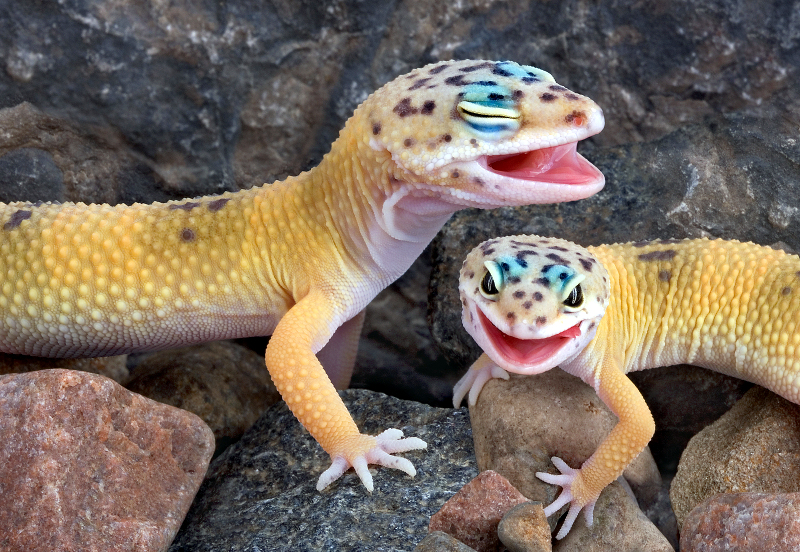
What Elements Make Up a Leopard Gecko’s Teeth?
Leo has teeth composed of the same substances that mammals do. Enamel serves as the delicate exterior layer of protection, and dentin lies beneath.
The majority of a tooth is made up of dentin, a yellowish substance that is firmer than bone but softer than enamel. The cement that holds the reptile’s tooth to its jaw bone is called cementum.
What Are The Similarities Of Leopard Geckos Teeth To Human Teeth?
The only thing about your teeth that makes them resemble geckos is the materials they are made of. Your pet has 100 small teeth compared to your 32, and you have four different types, including incisors, canines, premolars, and molars, each of which serves a certain purpose.
Leo has rows of small, temporary conical teeth, but a human has a second set that lasts their entire lives.
Human teeth require ongoing care. Geckos don’t experience this issue because they regularly regenerate all of their denticles due to tooth shedding.
How Sharp Are the Teeth of a Leopard Gecko?
The teeth of your gecko are tiny, highly sharp, and have pointed tips. They might be fearsome to small predators and insects, but that’s about it. They are far more effective at gripping than tearing or piercing due to their small size and high quantity.
Do Leopard geckos bite?
Not very often. Young leopard geckos bite more often than adult leopard geckos, but their teeth don’t hurt. Just make sure you wash your hands properly if you do get bit so that you don’t develop an infection.
Can The Teeth of a Leopard Gecko Pierce Human Skin?
There is a slim risk that your pet lizard will bite you and pierce your skin. This video demonstrates how the teeth are too little to penetrate.
Do Leopard geckos bites hurt?
Not typically. Gecko teeth are tiny and not typically super sharp. In rare instances, your leopard gecko might draw blood, but it doesn’t happen often.
Blood Drawn by Your Gecko
A leopard gecko bite can occasionally cause a little amount of blood to be drawn, but this is uncommon. If your leopard gecko bites and they draw blood, treat it like any other minor cut. Wash your hands in warm, soapy water first.
To avoid infection, apply some disinfectant when it has dried, then cover with regular plaster.
Do Not Respond Excessively to a Leopard Geckos Teeth Bite
Unfortunately, many new owners overreact when a leopard gecko bites them without warning. So many poor reptiles have been hurled through the air by a panicked person snatching their fingers away. But why, in the first place, would your adorable, placid lizard want to bite you?
After all, their laid-back disposition compels them to escape rather than engage in combat, making them ideal pets.
Here are four factors that could cause your pet leopard gecko to attack:
-
It gets scared or startled by something or someone.
-
Stress, such as improper tank temperatures, excessive handling, and others.
-
Your leopard gecko is hungry.
-
Your finger is mistaken for food.
Recognize the Warning Signs
Even reptiles experience terrible days and occasionally get out of bed on the wrong side. But in all seriousness, if your pet gecko doesn’t want handled, it will let you know.
If the tail wags frantically or points up as your hand approaches, don’t touch it. Hissing or shrieking are other red flags, but the latter is more typical of children than of adults.
If you don’t observe the warning signs and handle your gecko anyhow, it may bite you. But even worse than that, it might shatter any bonds or trust that had already formed.
Are Leopard Geckos Teeth Specially Cared For?
Leopard geckos are clean-living reptiles. You don’t need to follow any dental or oral hygiene regimens as the owner. However, regular pet care can help prevent infections in the mouth and teeth of your pet.
That entails eating balanced food and a healthy diet and maintaining a clean, optimum environment inside the container. Basic mistakes have repercussions.
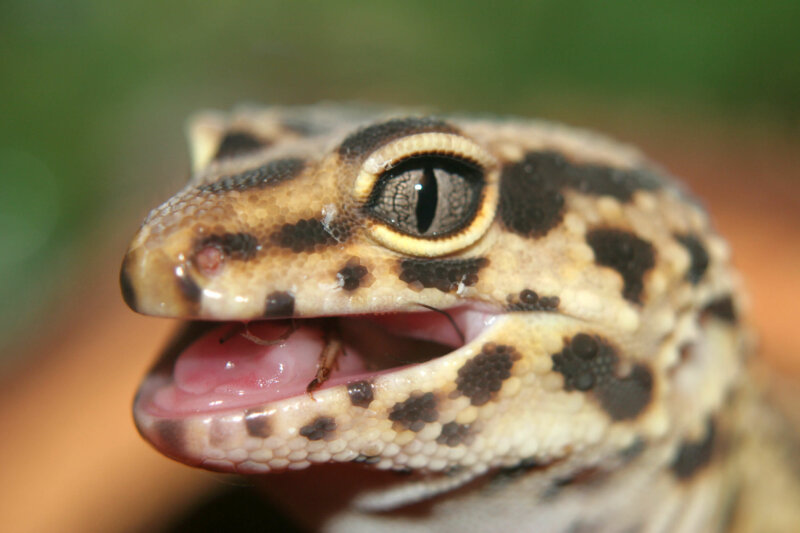
Mouth Rot in Leopard Geckos
First of all, there’s no need to be zealous and search for issues that don’t exist. All is well if Leo appears content, healthy, and acting normally. But in order to spot the warning indications of mouth rot, it pays to be knowledgeable about the condition.
Mouth rot frequently results from a bacterial infection caused by an infected lesion. Food that becomes stuck in the mouth is another source of infectivity. Good care typically stops this potentially catastrophic disease from developing.
The Risks of an Unhealthy Diet
Unskilled pet owners with good intentions could feed their lizards the wrong things. It doesn’t necessarily mean a reptile is healthy just because it consumes a “treat.”
The sugars in fruit and soft canned foods may cause gum and tooth disease. These issues are already problematic but may also be an early sign of deadly mouth rot.
A Contaminated Space
By regularly cleaning, you may keep undesirable bacteria out of Leo’s habitat. Maintaining the enclosure’s cleanliness makes sense because bacteria thrive in an unhygienic setting. Also, the proper heating and lighting levels aid in keeping your pet lizards’ mouths healthy.
Visible Inflammatory Symptoms
Visible inflammation is another possible sign of mouth rot. Usually, the face, mouth, or other areas of the head will swell. So it’s a good idea to periodically inspect the area surrounding your pet’s teeth for inflamed mouth tissue.
Fluid discharge is another thing to watch out for, especially puss around the nose that has a bad odor and is yellow in color.
A clearly enlarged head and face indicate an advanced case of mouth rot. Being a responsible pet owner, you’re more likely to identify and address minor signs far sooner.
Other Symptoms to Watch Out For
It’s time to stop relying on Dr. Google and consult a licensed veterinarian if your Leo begins to exhibit one or more of the four symptoms listed below.
-
It stops eating.
-
A mouth full with thick saliva.
-
A foul, lifeless tissue was found inside the mouth.
Should You Brush Your Leopard Geckos Teeth?
You don’t need to brush the tiny teeth of your leopard gecko. But occasionally, you might have to clean trapped dirt (substrate) out of its mouth. Turn your lizard gently onto its side and then rinse its mouth with warm water to do this.
The goal is to gently flush the substrate that has become stuck or any other obstruction away. Get a professional to remove it for you if it’s too stuck or if you’re too uncomfortable with the idea. This can be a stressful process for most geckos, so be gentle!
Which Diseases Can Harm Leopard Geckos Teeth?
Bacterial infections and mouth rot pose the greatest risk to the Leopard Gecko‘s teeth. Signs, symptoms, and prevention are covered in the earlier sections.
Frequently Asked Questions (FAQs)
Do leopard geckos have sharp teeth?
The teeth on your gecko are tiny but extremely sharp with pointed ends. To little insects and predators, they might seem intimidating, but that's about all. They are significantly more useful for grasping due to their small size and high quantity than for tearing or piercing.
Do leopard geckos bite hurt?
Bites from leopard geckos usually don't harm. If a leopard gecko bites you as an adult, you might feel a pinch or a small sting. If a baby gecko bites you, it probably won't hurt at all. Since leopard geckos rarely draw blood, a trip to the doctor is not required.
Can leopard geckos lose their teeth?
Actually, leopard geckos have 100 teeth, which erupt and are replaced every three to four months. Each fully-grown tooth is followed by a smaller replacement tooth, ensuring that a new tooth is present when the old one falls out.
Are leopard geckos supposed to have teeth?
Do leopard geckos have teeth, then? It does, and there are quite a few of them. 100 teeth are present when a leopard gecko hatches from its egg.

